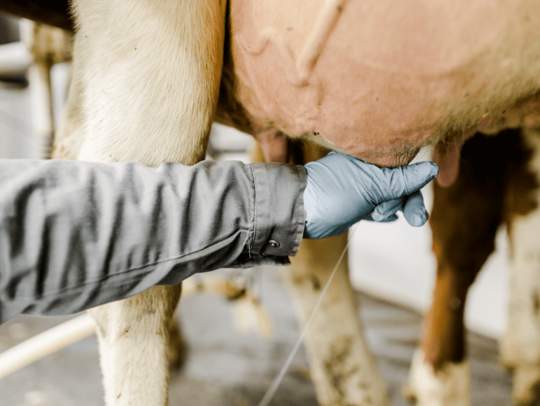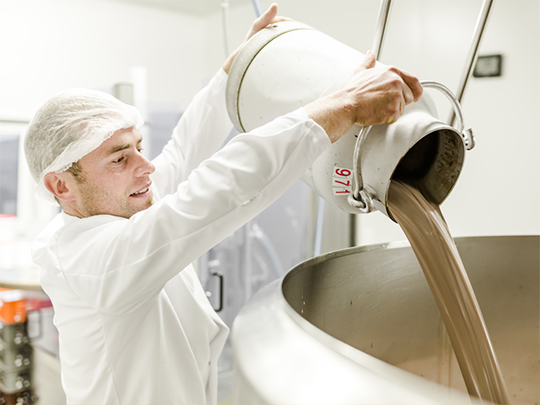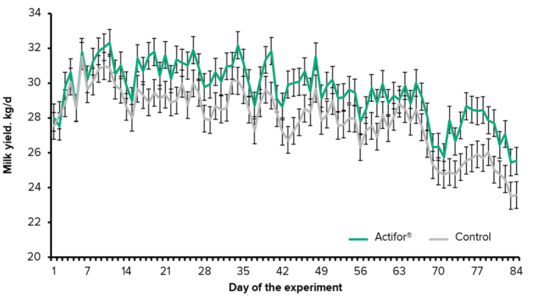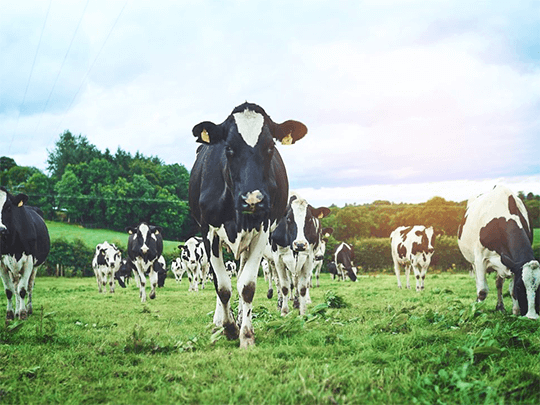Phytogenic feed additives in dairy cattle - Support for best protein efficiency (part 2)
In part 1 of this article you could already learn about NUE, nitrogen balance and protein supply in ruminants. In part 2 of this article we will explain what the ruminohepatic cycle is and what it has to do with milk urea nitrogen. In this part you will also learn about the effects of phytogenic feed additives on protein efficiency and milk yield in ruminants....
Ruminohepatic circle and milk urea nitrogen (MUN)

The ruminohepatic circle describes the circulation between rumen and liver in ruminants, leading to better utilization of feed N. In the rumen, NH3 is produced via deamination of amino acids or non-protein compounds (e.g. urea and amides). The ammonia may be used for microbial growth, providing that energy is available.
The ammonia released in the proventriculus is directly absorbed, reaches the liver directly (via blood), where it is converted into urea and thus detoxified. The urea formed in the liver returns to the rumen via the salivary glands and through direct back diffusion via the rumen wall, where it is split into ammonia (NH3) and carbon dioxide (CO2) with the help of a bacterial urease.
This makes it available again for amino acid synthesis by the bacteria living in the rumen. Urea that is not recirculated is excreted via the kidneys. Though part of the urea is released via the milk. The milk urea content in milk production describes the urea content in milligrams per liter (mg/l) of milk.

The MUN represents a helping tool to monitor the nutritional condition of the cow. As a waste product of the amino acid metabolism, it allows conclusions about the protein and energy supply of the animals and can be used to acquire a general estimate of the NUE of the herd.
Recommended MUN values range from 10-15mg/dl milk but recent research has reduced the advised range to 8-12mg/dl to reduce ammonia levels in the rumen, hence making interpretation challenging. Typically, high MUN values indicate a low NUE and a high level of N losses in urine. Factors like feeding, breed (respectively body weight), or season seem to have an impact on the MUN.
Conclusions on the N efficiency can be drawn from the milk and blood urea N. The MUN may increase consequently to excessive protein or rumen degradable protein input. As the MUN is in close relationship to the urinary N excretion, it may be a helpful tool to reduce excessive N excretion. Providing adequate rumen available carbohydrates as energy source for the rumen microbes, making them convert ammonia into microbial protein seems to be a crucial target.

Feed the rumen - with phytogenic feed additives
Do not feed the cow, but the bacteria in the rumen. The bacterial flora in the stomachs of ruminants is supported by the optimal composition of the feed. A well-balanced amount of energy and protein supply is essential, if you´d like to use the rumen of dairy cows to its full potential. Only an optimal microbial composition makes it possible to absorb nutrients from the ration in the best possible way.
Milk production is strongly connected to the digestible protein supply available in the intestine. This once again shows the importance of high-quality microbial protein being washed from the rumen to the intestine.
Did you know?
Phytogenic (plant-based) feed additives (PFA) have been able to substantially up-value ruminant rations for years. Well-formulated formulations, aligned to the animal’s needs, are able to support protein efficiency hence helping to keep protein losses low. There is evidence that these natural, holistic solutions, made of e.g. essential oils, saponins, spices and condensed tannins unfold their impact on three levels and in various sections of the digestive tract:
- In the rumen: improved rumen function leads to improved energy and protein efficiency ratio, increasing the proportion of metabolizable bypass protein and microbial protein (the latter shows a very good amino acid balancing to build up milk casein). Consequently, this will lead to lower ammonia losses from the rumen, via the liver (where it is transformed to urea) into the urine.
- A reduction of the protein degradation in the rumen will increase the level of bypass protein, and thus, lowering protein losses.
- The natural ingredients of selected PFAs positively influence the protein digestibility and absorption in the small intestine. By increasing the proportion of metabolizable bypass protein and microbial protein, the share of indigestible protein is minimized. This will reduce protein in feces and lower ammonia concentrations.
The positive performance effects of a well-formulated phytogenic feed additive (Actifor® Pro) are illustrated in figure 3. Specific phytogenics have shown to reduce both protein losses in urine and feces. This means that the intestinal digestibility could be improved, and less ammonia was transformed into urea.
The more efficient use of N for milk production, maintenance and growing led to an improved protein efficiency by 2.7%. Optimizing protein and feed efficiency in ruminants improves the milk quality by raising its protein content whilst simultaneously decreasing urea concentration. MUN was decreased from 261mg/l in control animals to 219 mg/l in cows fed the PFA (data not shown).
| Control group | Actifor® group | Actifor® Pro Effect | p-value | |
| DIM at beginning (days) | 84.9 | 87.6 | NS | |
| Milk yield (kg/cow/day) | 27.9 | 29.5 | +1.6 | 0.04 |
| Energy Corrected Milk (kg/cow/day) | 30.5 | 33.0 | +2.5 | 0.01 |
| Fat corrected milk (kg/cow/day) | 30.0 | 32.6 | +2.6 | 0.02 |
| BCS change | +0.07 | +0.22 | +0.15 | 0.05 |
| Energy output (Mcal/day) | 20.5 | 22.3 | +1.8 | 0.02 |

Another study using Actifor® Pro was undertaken in Brazil, to look at the potential to improve performance in dairy cows over a period of 12 weeks (see table 1 and figure 4). The inclusion of the phytogenic feed additive mainly increased milk production (+ 1.6kg/cow/day) and the energy corrected milk production (+ 2.5kg/cow/day). At the same time, body condition score was increased by 0.15.

Supplementing lactating dairy cows with well selected phytogenic feed additives like Actifor® Pro appears to be a promising strategy to improve milk performance, whilst at the same time reduce protein losses in dairy production systems. Possible reduction of crude protein level in diets due to in-feed phytogenics consequently will lead to decreased feed costs as well.
To sum up...
In dairy milk production attention is mostly concentrated on efficiency. Therefore, maintaining very high-quality rations, hence making it possible to fully exploit the genetic potential of the dairy cows, plays an important role in optimal management. There is evidence that optimizing rations with phytogenic feed additives represents reliable, cost effective ways, ensuring feed efficiency respectively protein efficiency. This does not only lead to improved animals’ performance but also contributes to a cost-efficient milk production, animal well-being and environmental protection.
References upon request
This article originally appeared in International Dairy Topics, Volume 19, Number 2.











Helpful